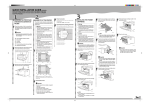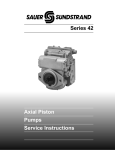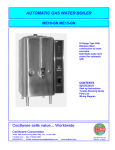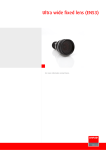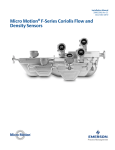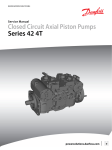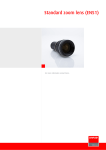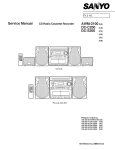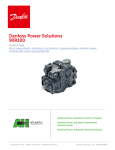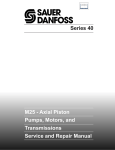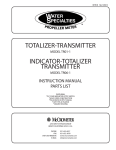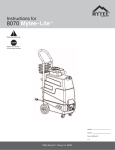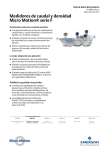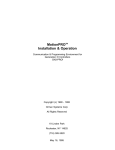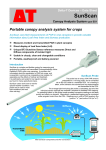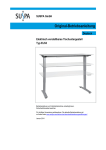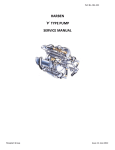Download 10094 S01 S42 Repair
Transcript
CONTENTS saue Series 42 Axial Piston Pumps Repair Manual CONTENTS saue Series 42 Repair Introduction 1. Introduction 1.1 Using This Manual This manual provides "Major Repair" procedures for the Series 42 variable displacement pumps. Minor Repairs are those which can be performed without removing the side cover. These repairs may be performed without affecting the unit warranty and are outlined in the Series 42 Service Manual (BLN10093). Major Repairs are those repairs that require the removal of the side cover. These repairs are to be performed only by Sauer-Sundstrand Authorized Service Centers and / or original equipment manufacturers who have been adequately trained by SauerSundstrand to perform these repairs. 1.2 Performing major repairs on the Series 42 products may affect the unit warranty status, thus the factory should be consulted prior to undertaking such repairs. These repair procedures, when used in conjunction with the procedures in the Series 42 Service Manual, provide complete service and repair information for Series 42 products. It is necessary to have the Service Manual on hand to complete major repairs. Safety Precautions Always consider safety precautions before beginning a service procedure. Protect yourself and others from injury. The following general precautions should be taken into consideration whenever servicing a hydrostatic system. Loss of Hydrostatic Braking Ability WARNING When Series 42 units are used in vehicular hydrostatic drive systems, the loss of hydrostatic drive line power in any mode of operation (e.g. acceleration, deceleration or “neutral” mode) may cause a loss of hydrostatic braking capacity. A braking system which is independent of the hydrostatic transmission must, therefore, be provided which is adequate to stop and hold the system should the condition develop. Disable Work Function WARNING Certain service procedures may require the vehicle / machine to be disabled (wheels raised off the ground, work function disconnected, etc.) while performing them in order to prevent injury to the technician and bystanders. Copyright 1997, Sauer-Sundstrand Company. All rights reserved. Contents subject to change. Printed in U.S.A. F100 003 2 Fluid Under High Pressure WARNING Use caution when dealing with hydraulic fluid under pressure. Escaping hydraulic fluid under pressure can have sufficient force to penetrate your skin causing serious injury. This fluid may also be hot enough to burn. Serious infection or reactions can develop if proper medical treatment is not administered immediately. Flammable Cleaning Solvents WARNING Some cleaning solvents are flammable. To avoid possible fire, do not use cleaning solvents in an area where a source of ignition may be present. Personal Safety WARNING Proper safety equipment, including safety glasses, should be used at all times. CONTENTS saue Series 42 Repair Introduction Contents 1. Introduction .................................................................................................................................................2 1.1 Using This Manual ................................................................................................................................ 2 1.2 Safety Precautions ...............................................................................................................................2 1.3 Symbols Used in Sauer-Sundstrand Literature .................................................................................... 4 1.4 Ordering Replacement Parts and Service ............................................................................................ 4 2. General Instructions ................................................................................................................................... 5 3. Disassembly ................................................................................................................................................ 6 4. Subassembly Repair and Inspection ...................................................................................................... 12 4.1 Cylinder Kit ......................................................................................................................................... 12 4.2 Servo Piston ....................................................................................................................................... 14 4.3 Valve Plate and Servo Covers ............................................................................................................ 17 4.4 Shaft Assembly ................................................................................................................................... 18 4.5 Swashplate and Swashplate Bearings ............................................................................................... 19 4.6 Charge Pump Group .......................................................................................................................... 20 4.7 Charge Pump Cover, Seal Carrier, and Control Linkages .................................................................. 21 5. Reassembly ...............................................................................................................................................22 6. Exploded View Parts Drawings ................................................................................................................ 32 6.1 Shaft Options ......................................................................................................................................32 6.2 Filtration, Charge Relief, System Relief, and Loop Flushing .............................................................. 34 6.3 Charge Pump, Auxiliary Pads, and Servo Covers .............................................................................. 36 6.4 Control Options .................................................................................................................................. 38 6.5 Servo Piston, Swashplate, and Bearings ........................................................................................... 40 6.6 Servo Covers and Cylinder Kit ........................................................................................................... 42 6.7 Nameplate .......................................................................................................................................... 43 3 CONTENTS saue Series 42 Repair 1.3 1.4 Introduction Symbols Used in Sauer-Sundstrand Literature DANGER! May result in injury. Lubricate with hydraulic fluid. May result in immediate or premature damage. Apply grease / petroleum jelly. Reusable part Apply locking compound. Nonreusable part, use a new part. Inspect for wear or damage. Non-removable item Clean area or part. “OR” in drawing – either option may exist. Be careful not to scratch or damage. Measurement required. Note correct orientation. Flatness specification Mark orientation for reinstallation. Parallelism specification Torque specification External hex Press in. Internal hex Pull out with tool. Torx head Use installation sleeve / cone (bullet). Ordering Replacement Parts and Service To ensure the best performance, order genuine SauerSundstrand replacement parts. See BLN-2-41668 (28 cc) or BLN-2-41691 (41 cc) for listings of available service parts and service kits for Series 42 units. To order parts, contact Sauer-Sundstrand Extended Customer Service (ECS) at (515) 239-6078, fax (515) 239-6230, or your nearest Authorized Service Center. Some service parts may be available only in kits, while other parts may be available on an individual basis. Sauer-Sundstrand provides a complete repair service for its products. Contact any Sauer-Sundstrand Authorized Service Center for details. Sauer-Sundstrand Authorized Service Center locations are listed in BLN-2-40527, or Publication SAW (Id. No. 698266). 4 CONTENTS saue Series 42 Repair General Instructions 2. General Instructions Remove the Pump! Inspect for System Contamination! Prior to performing major repairs on the Series 42 pump, remove the pump from the vehicle. Chock the vehicle to prohibit movement. Be aware that hydraulic fluid may be under high pressure and / or hot. Inspect the outside of the pump and fittings for damage. Inspect the pump for system contamination. If contamination is found, or is known to be present, all components of the pump should be fully disassembled, cleaned, and inspected using Series 42 Service Manual (BLN-10093) in conjunction with this manual. Replace the O-rings and Gaskets! Mark the Orientation! Using a permanent or dye marker, mark the side of the housing that has the neutral adjustment tie bolt (G053) sticking out, as illustrated below. Make the mark directly on the housing (not the servo cover). Keep it Clean! Cleanliness is a primary means of assuring satisfactory pump life, on either new or repaired units. Clean the outside of the pump thoroughly before disassembly. Take care to avoid contamination of the system ports. Cleaning parts by using a clean solvent wash and air drying is usually adequate. As with any precision equipment, all parts must be kept free of foreign materials and chemicals. Protect all exposed sealing surfaces and open cavities from damage and foreign material. If left unattended, the pump should be covered by a protective layer of plastic. It is recommended that all O-rings and gaskets be replaced. Lightly lubricate all O-rings with clean petroleum jelly prior to assembly. Lubricate all Moving Parts! During reassembly, all parts which have relative motion between two surfaces should be coated with a film of clean hydraulic oil. This will help to lubricate these surfaces during start-up. For fluid quality requirements, refer to bulletin BLN-9887. Orient the Pump! For major repair, place the transmission in a stable position with the input shaft pointing upwards, as illustrated above. It may be necessary to secure the pump to prevent personal injury and allow bolts to be adequately torqued. Front Face Left Face Top Face Bottom Face Right Face Rear Face E100 110E Pump Face Orientations 5 CONTENTS saue Series 42 Repair Disassembly 3. Disassembl 1. Remove the 'B' Pad Cover Plate (4.5 in. dia., G085, p. 11) or Auxiliary Pump, if Present. Note: Record or mark the auxiliary pump or 'B' pad cover plate orientation for reassembly purposes. 'A' pad cover plate (3.5 in. dia.) removal is not necessary for major repair. Remove the auxiliary pump or 'B' pad cover plate bolts (2) using a 3/4 in. hex wrench or 3/8 in. internal hex wrench. F091 Remove the O-ring from the auxiliary pump or cover plate. 2. Remove the Case Drain Plug. Using a 9/16 in. internal hex wrench (28 cc) or a 5/8 in. internal hex wrench (41 cc), remove the case drain plug (F091) or corresponding hose to relieve the formed vacuum that may prevent the removal of the input shaft. 3. Remove the Seal Carrier Retaining Ring. Rotate the pump so that the input shaft points upwards. Use a flat head screwdriver to remove the seal carrier retaining ring (F096). Some earlier production models may contain an internal snap ring that requires a large pair of internal snap ring pliers for removal. 28 cc: 9/16 in. 41 cc: 5/8 in. E100 114 Unit in Upright Position F096 C020 Screwdriver Pry Point C017 4. Remove the Seal Carrier Assembly. It may be necessary to use a flat head screwdriver along the raised surface of the seal carrier to remove the seal carrier assembly (C020) as shown at right. Since only friction is holding the input shaft in place, it may be possible (but difficult) to ease seal carrier removal by lifting on the shaft. It is advised that the shaft lip seal (C018, p. 21) be replaced on all major repairs. Press the seal from the carrier. Remove and discard as outlined on page 21. Remove and discard the O-ring (C017) from the seal carrier or housing. 6 E100 115E Seal Carrier Removal CONTENTS saue Series 42 Repair Disassembly 5. Remove the Shaft Assembly. Grip the splines of the input shaft and lift the shaft assembly from the unit. 6. Remove the Side Cover Bolts. The six (6) side cover bolts (F007) may be removed using a Torx T-30 wrench. Shaft Assembly 7. Remove the Side Cover. The side cover may be press fit to the housing and (F2) contains swashplate bearings that are under load. To remove the side cover, it is necessary to press the swashplate down using the handle of a clean rubber mallet as illustrated at right. Apply force towards the center of the pump on the side cover end of the swashplate. If the side cover does not disengage from the housing, it may be necessary to first tap the side cover with a dead blow as indicated at right to separate the side cover from the gasket. E100 116E Shaft Removal Push Rubber Mallet F008 F2 F007 Dead Blow Point T-30 Dead Blow Point E100 118E Side Cover Removal 7 CONTENTS saue Series 42 Repair Disassembly 8. Remove the Cylinder Kit. Lift the exposed end of the swashplate (B011) and slide the cylinder kit (N001) from the housing. Note: Be careful not to scratch or damage the top or bottom surface of the cylinder kit. Place the cylinder kit in a clean environment. 9. Remove the Swashplate. To remove the swashplate (B011) through the side cover opening it is necessary to tilt the swashplate at an angle as it is pulled from the swashplate needle bearing (B010). Lift B011 N001 10. Remove the Swashplate Needle Bearing Assembly. Reach through the side cover opening and slide the swashplate needle bearing and carrier (B010) from the servo piston bearing cavity. It may be necessary to rotate the servo piston (G100, p. 10) so that the bearing may be removed. 11. Remove the Valve Plate. Lift the valve plate (N006) from the housing. It may be necessary to use a small flat head screwdriver to loosen the valve plate from the pump housing. Note: Be sure not to scratch or damage either surface of the valve plate. Be careful not to nick the valve plate when it breaks loose from the housing. Place the valve plate in a clean environment. 12. Remove the Valve Plate Timing Pin. The valve plate timing pin (F006) is located at the bottom of the side cover interface. Slide the pin out of the housing. E100 119E Cylinder Kit Removal B010 B011 E100 120 Swashplate Removal Note: It is easy to confuse the valve plate timing pin and gerotor cover orientation pin (G065, p. 11). The timing and orientation pins are dimensionally identical, except in length. The valve plate timing pin length is 15.89 mm (0.625 in.) and the gerotor cover orientation pin measures 12.70 mm (0.500 in.). Do not interchange these pins on reassembly! N006 F006 Valve Plate Removal 8 E100 121 CONTENTS saue Series 42 Repair Disassembly D082 D081 Step 13, Control and Control Linkage Removal, is not necessary unless the servo piston is going to be removed or the unit has experienced contamination. 13. Control and Control Linkage Removal FNR and NFPE Controls, page 38. FNR (D004; electric three position) and NFPE (D060; non-feedback proportional electric) style controls do not need to be removed for major repair unless contamination is suspected (see Series 42 Service Manual, BLN-10093 for more information). T-30 D003 D002 T-30 3/16 in. D080 D070 E001 Manual and Electrical Displacement Controls. For MDC (D070) models, remove the alignment plug (D003) using a 3/16 in. internal hex wrench. MDC and EDC (D080) modules may be detached by removing the seven (7) mounting bolts (D002, D081, D082) with a Torx T-30 wrench. It may be necessary to lightly tap on the steel body of the control with a rubber mallet to loosen it from the housing. Remove the control gasket (E001). Note: The holes in the control gasket act as regulating orifices. Refer to the appropriate Service Parts List and your order code to determine the correct replacement gasket. The summing link (D011), feedback link (D012), and neutral adjustment link (D013) must be removed. Take note of the manner in which the parts are assembled and the way in which the summing link engages the control spool. Remove the summing link by sliding it off the feedback link. E100 112 Control Removal D011 D010 D012 4 mm D013 Remove the linkage pivot screw (D010) using a 4 mm internal hex wrench. Slide the feedback link towards the servo piston to disengage the neutral adjustment link. All linkages should now be removed. E100 113 Control Linkage Removal 9 CONTENTS saue Series 42 Repair Disassembly 14. Remove the Tie Bolt Side Servo Cover. Remove the servo cover (M001) that does not have the neutral adjustment tie bolt (G053) sticking out of the center. Use a Torx T-30 wrench to remove the five (5) servo cover bolts (L005). Also remove the servo cover gasket (F009). L005 M001 F009 T-30 L001 15. Remove the Servo Adjustment Seal Nut. Using a 13 mm or 17 mm six point socket, remove and discard the servo adjustment nut (G060). Use a 5 mm or 7 mm hex wrench to hold the tie bolt (G053) for removal. Note: Once a servo adjustment seal nut has been removed, it should be discarded and replaced because it will lose its sealing properties. 16. Remove the Other Servo Cover and Piston. Remove the five (5) servo piston bolts (L005) with a Torx T-30 wrench. Pull the remaining servo cover (L001) and attached servo piston (G100) from the pump. After the servo cover and piston have been removed from the pump, remove the servo cover from the servo piston tie bolt (G053). G053 5 mm or 7 mm E100 122 Servo Cover Removal G052 F002 If none of the following statements are true, the rest of section 3, Disassembly, may be skipped. Otherwise continue with step 17. • The input shaft does not demonstrate spalling from the rear needle bearing, as illustrated on page 18. • • No contamination has entered the pump. The unit does not demonstrate any charge pump problems. 17. Remove the Charge Pump Cover. Rotate the pump so that the charge pump cover (G001) is pointing upwards as illustrated on page 11. Using a T-45 wrench, remove the seven (7) bolts (G036, 6 bolts on 'B' pad units) that attach the charge pump cover to the pump housing. It may be necessary to tap the cover with a rubber mallet to loosen it from the housing. 18. Remove the Charge Pump Cover Gasket. Remove and discard the charge pump cover gasket (G030, p. 11). 10 G100 G060 B010 B013 13 mm or 17mm E100 123 Servo Piston Removal CONTENTS saue Series 42 Repair 19. Remove the Gerotor Cover. Two O-rings (G022, G023) accompany the gerotor cover (G020) removal. Early models with an 'A' pad option may contain a third O-ring (G021, p. 36). 20. Remove the Gerotor Assembly. The gerotor assembly (G010) may remain in the gerotor cover (G020) upon disassembly. Disassembly 9/16 in. 3/4 in. G090 G085 G036 G080 Units not containing an integral charge pump will not have a gerotor assembly present. 21. Remove the Defeat Plug (no charge pump units only). Units without an integral charge pump may contain a charge pump defeat plug (F020). Excluding early production models, the defeat plug is tapped to use an M6 threaded bolt for removal. All servo cover and control bolts have an M6 thread. Remove by pulling from the unit. Remove and discard the defeat plug Oring (F020A). T-45 G001 G030 22. Remove the Drive Coupling and Drive Pin. Remove the drive coupling (G005) from the pump. Take care to not lose or drop the drive pin (G002) into the unit. G023 Some 41 cc units may contain a washer style spacer (G005) under the drive coupling that requires removal. G020 Units without an integral charge pump will not contain a drive pin. G010 23. Remove the Alignment and Orientation Pins. Three pins are present at the interface. Two large pins (G075) align the charge pump cover. A third and smaller pin (G065) orients the gerotor cover. It is possible that the gerotor orientation pin may remain in the gerotor cover on removal. Units without charge pumps will not contain the third (smaller) orientation pin. It may be difficult to remove the pins due to a vacuum formed in the cavity. G022 F020A G005 F020 G002 G075 G005 (Some 41 cc only) G065 G075 Note: Be careful to not drop any of the pins into the unit. 24. Remove the Shaft Needle Bearing. As needed, press the shaft needle bearing (F002, p. 10) from the housing. If a press is not available, it is possible to use an appropriately sized socket and extension to press the bearing from the housing. E100 111E Charge Pump and Cover Removal Protect the charge pump surface from damage during this procedure. 11 CONTENTS saue Series 42 Repair Subassembly Repair and Inspection 4. Subassembly Repair and Inspection 4.1 Cylinder Kit The cylinder kit (N001), also referred to as the 'rotating group', is comprised of nine (9) pistons, with a swiveling brass 'slipper' attached to each piston. The slipper retainer (F028) holds the pistons (F029) upright and aligned with the corresponding cylinder. The slipper retainer pivots on a ball guide (F027) which transfers the downward force of the slippers and pistons to three hold down pins (F025). The hold down pins then transfer the downward force to the cylinder block spring (F022), and eventually to the cylinder block (F020). F029 F028 F027 F026 F025 Disassemble the Cylinder Kit. Remove the pistons from the cylinder kit. The pistons and bores are not selectively fitted, so it is usually not necessary to replace the pistons in their original bores. However, units with high hours may begin to develop wear patterns, and it is advisable to replace the pistons into the original bores if at all possible. N001 F020 F021 Remove the ball guide (F027). The three hold down pins (F025) may now be removed. A retainer ring (F026) is used to hold the pins in the upright position. Due to prior assembly, the retainer ring will be resting at the bottom of the cylinder block (F020). It may be necessary to use a packing hook to remove the ring. F022 F023 F024 E100 124 Cylinder Kit Disassembly Inspect the Cylinder Block. First look at the bottom of the cylinder block (F020). The running surface, or face which contacts the valve plate, should be smooth and free of nicks and burrs. No scratches or grooves noticeable to the touch are allowed, as these may drastically affect the flow of the unit. Running face flatness should be flat to 0.002 mm (0.000079 in.) TIR convex for 28 cc and 41 cc cylinder blocks. Maximum inside cylinder bore diameters should be 14.30 mm (0.5631 in.) for 28 cc cylinder blocks and 16.14 mm (0.6353 in.) for 41 cc cylinder blocks. Minimum cylinder block height is 50.00 mm (1.968 in.) for 28 cc blocks and 55.88 mm (2.200 in.) for 41 cc blocks when measured as illustrated at right. F020 Minimum Cylinder Block Height: 28 cc: 50.00 mm 1.968 in. 41 cc: 55.88 mm 2.200 in. Running Face Flatness 28 cc: 41 cc: Flat to 0.00201 mm TIR Convex (Flat to 0.000079 in. TIR Convex) Cylinder Block Minimum Height 12 P100 362E CONTENTS saue Series 42 Repair Inspect the Rotating Group Pistons / Slippers Look for any discoloration on the pistons (F029). Holding a white piece of paper behind each piston helps to indicate discolorations. Discolored pistons indicate that the unit was subjected to excessive temperature and should not be reused. The slippers may now be inspected for signs of excess wear or damage. The minimum slipper foot thickness is 3.33 mm (0.131 in.) for 28 cc models and 3.68 mm (0.145 in.) for 41 cc models. Slipper end play should be 0.152 mm (0.006 in.) or less for 28 cc and 41 cc models. Discard and replace all piston assemblies if brass slippers are scored, excessively rounded at the edges, or detached from the piston. Subassembly Repair and Inspection Maximum End Play: Minimum Slipper Foot Thickness: 28 cc: 3.33 mm (0.131 in.) 41 cc: 3.68 mm (0.145 in.) Slipper F029 E100 125E Rotating Group Piston If Needed, Fully Disassemble the Cylinder Block. Note: This step is not necessary for most normal repairs and should not be performed unless internal damage is suspected or the pump has become contaminated (contamination may remain in the spring cavity). Be careful not to scratch or damage the cylinder block during this process. Compress the cylinder block spring (F022) and remove the spiral retaining ring (F024), outer washer (F023), spring, and inner washer (F021). Visual inspection of the cylinder block, spring, and washers should indicate minimal wear. Replace if cracks or damage are present. Reassemble in the reverse order. Reassemble the Cylinder Kit. A light coating of hydraulic fluid should be used to coat all parts prior to reassembly. Place the retainer ring (F026, p. 12) in the cylinder block (F020) so that it sits approximately 1/8 in. below the top surface. Insert the three hold down pins (F025) and make sure that they sit squarely in their respective grooves. Replace the ball guide (F027). Insert the slipper retainer (F028) containing the slippers and pistons (F029). Once the entire cylinder block has been reassembled, check to be sure that the ball guide sits squarely on all three pins. The retainer ring should still remain approximately 1/8 in. below the top of the cylinder block. 28 cc: 41 cc: 0.152 mm (0.006 in.) F020 F021 F022 F023 F024 E100 126 Cylinder Block Disassembly E100 127 Assembled Cylinder Kit Note: Be sure to install the slipper retainer (F028) so that it mates correctly with the ball guide (F027; concave side of the slipper retainer against the ball guide). 13 CONTENTS saue Series 42 Repair 4.2 Subassembly Repair and Inspection Servo Piston Inspect the Servo Piston. Inspect the housing and housing servo bore to ensure no piston ring fragments were deposited during servo piston removal. Remove and discard the piston rings (G052) and O-rings (G051) from the servo piston. X2 G100 G053 G051 G052 Piston ring and O-ring installation procedures are outlined in section 5, Reassembly. Measure Servo Piston Torque to Turn Check to see that the servo piston (G100) is correctly adjusted. Holding the servo piston stationary in one hand, measure the torque required to twist the neutral adjustment tie bolt (G053) after break away. 28 cc and 41 cc model servo piston tie bolts use a 5 mm and 7 mm hex wrench, respectively. The torque to turn the tie bolt must be 0.23 Nm (2 in•lbf) and above for 28 cc units, 0.68 Nm (6 in•lbf) and above for 41 cc units, and 1.13 Nm (10 in•lbf) or above models with NFP controls. The servo piston torque to turn must meet the minimum specifications in each direction of rotation. 13 mm or 17 mm E100 135 Servo Piston Inspection G059 13 mm or 17 mm 24 mm G058 G057 G054 When testing the torque to turn, the large nut (G057) is permitted to turn, but the upper spring guide (G054) should not turn. This may be unavoidable in some instances. If the servo piston does not meet the above requirements, it is necessary to loosen the nuts and repeat the adjustment procedure outlined in Adjustment of Servo Piston Torque to Turn on page 16 until the desired results are achieved. Several attempts may be necessary before correctly setting the piston assembly. G060 G055 G056 5 mm or 7 mm G053 G050 E100 156 Servo Piston Components 14 CONTENTS saue Series 42 Repair Subassembly Repair and Inspection Complete Piston Disassembly Contamination or damaged parts may require the complete disassembly of the servo piston. It is not necessary to completely disassemble the servo piston assembly if only torque to turn adjustment is desired. G059 13 mm or 17 mm 24 mm Holding the tie bolt with a 5 mm or 7 mm wrench, tighten the small nut until the spring compresses enough to relieve all pressure from the snap ring (G059). Remove and discard the snap ring. G057 G054 G055 Remove the nuts (G058, G060) from the tie bolt (G053) using a 13 mm or 17 mm hex wrench and a 24 mm hex wrench. Replace and hand tighten the small nut (G058). G058 G056 5 mm or 7 mm G053 G050 Remove the spring assembly. If necessary, disassemble the spring assembly. Remove the two nuts (G058, G057), upper and lower spring guides (G054, G056), spring (G055), and tie bolt (G053). NFP models may also contain shims that must be reused during reassembly. E100 156 Servo Piston Components Wash all parts in a clean solvent wash and allow them to air dry. 15 CONTENTS saue Series 42 Repair Piston Reassembly Place the lower spring guide (G056) on the tie bolt (G053). Notice that the lower spring guide has a distinguishing counter bore on one side. Place the spring (G055) over the tie bolt. Subassembly Repair and Inspection G059 13 mm or 17 mm 24 mm G058 G057 G054 Place the upper spring guide (G054) on the tie bolt. Install the large servo nut (G057) on the tie bolt and run it down by hand until it contacts the upper spring guide. Hand tighten the nut against the upper spring guide. Run the small nut (G058) down the tie bolt until it loosely contacts the large servo nut. G055 G056 5 mm or 7 mm G053 Place the assembly into the servo piston body (G050). Compress the piston assembly so that the snap ring may be inserted. If a press is not available, it is possible to compress the spring by tightening the nuts on the tie bolt. It may be necessary to temporarily insert a spacer between the top spring guide and nuts. Install a new snap ring (G059) into the piston. Release the piston assembly from the compressed position so that all of the pressure now lies on the snap ring, and the tie bolt is free to spin. Set the piston assembly on a flat surface with the tie bolt pointing upwards. Adjustment of Servo Piston Torque to Turn Ensure that both nuts (G057, G058) are loose and the entire spring load is resting on the snap ring. Hold the large nut stationary using a 24 mm hex wrench and hand tighten the tie bolt by turning the stud CCW until it is finger tight. While holding the large nut stationary, use a 5 mm or 7 mm hex wrench to tighten (CCW) the tie bolt until the spring has just begun to compress. Back off (CW) the the tie bolt approximately 1/16 turn. This will serve as an approximation for setting the servo piston torque. While holding the large nut stationary with, torque the smaller nut to 20-27 Nm (15-20 ft•lbf). Measure servo piston torque to turn as outlined on page 14. Readjust if torque specifications are not met. When attempting fine adjustment, back the small nut off slightly, turn both nuts on the tie bolt (G053) together, and then retorque the small nut while holding the large nut stationary. 16 G050 E100 156 Servo Piston Components CONTENTS saue Series 42 Repair 4.3 Subassembly Repair and Inspection Valve Plate and Servo Covers Inspect the Valve Plate. Valve plate thickness (N006) should be no less than 4.97 mm (0.196 in.) for 28 cc model valve plates and 3.86 mm (0.152 in.) for 41 cc model valve plates. Appearance should be flat and smooth on both the running face and the bottom. Parallelism for 28 cc and 41 cc model valve plates should be 0.0249 mm (0.00098 in.) or less. Valve plate flatness should measure flat to 0.0038 mm (0.00015 in.) convex for 28 cc and 41 cc models. A magnetic particle inspection is recommended to detect cracks. Cracks are not allowed on any surface of the part. Run a fingernail or pencil tip across the diameter of the sealing land surface (see illustration at right). No deep or outstanding grooves are allowed, as these may cause a decrease in pump flow. Lap (to within specification) or replace if grooves or nicks are present. Minimum Thickness: 28 cc: 4.97 mm (0.196 in.) 41 cc: 3.86 mm (0.152 in.) Parallelism: 28 cc: 0.0249 mm (0.00098 in.) 41 cc: 0.0249 mm (0.00098 in.) Flatness (maximum convex): Flat to: 28 cc: 0.0038 mm (0.00015 in.) 41 cc: 0.0038 mm (0.00015 in.) N006 P100 366E Valve Plate Specifications N006 Clockwise (CW) and counter-clockwise (CCW) valve plate orientations are shown at right and may be distinguished by the direction of the dominant 'fish tails'. Inspect the mating surfaces of the valve plate and housing for any possible contamination, as even a few thousandths of an inch of contamination may be cause for low pump flow. Inspect the Servo Covers. Inspect the servo covers (M001, L001) to ensure that the gasket mating surfaces are clean and smooth. No scratches are allowed on the mating surfaces. Clean as necessary. Discard and replace the servo cover gaskets. Sealing Land Surface P100 367E Valve Plate Inspection CCW N006 CW P100 372 Valve Plate Orientations M001 L001 Tie Bolt Hole Servo Cover Inspection E100 134E 17 CONTENTS saue Series 42 Repair 4.4 Subassembly Repair and Inspection Shaft Assembly Inspect the Input Shaft. Check to see that the input shaft (C001) and its splines are straight and free of damage or heavy wear. Inspect the shaft surface where it meets the shaft seal. If a groove is formed that may let dirt into or hydraulic fluid out of the unit, replace the shaft. Inspect the surface where the rear shaft bearing (F002, p. 24) contacts the shaft (see right). If spalling is present, replace the shaft and rear shaft needle bearing. Clean the sealing area with a nonabrasive material, if necessary. Lubricate the shaft with a light coating of hydraulic fluid. C018 C001 E100 131 Input Shaft Inspection Inspect the Shaft Roller Bearing. Rotate the shaft roller bearing (C003) to check for smoothness. If a contaminated or damaged bearing is suspected, clean with a solvent and re-lubricate with hydraulic fluid. If the problem is not remedied by cleaning, replace the bearing. If either the shaft or roller bearing are to be replaced, disassemble and reassemble the shaft assembly as outlined below. C003 E100 132 Shaft Roller Bearing Inspection Remove the Shaft Snap Ring. Using a pair of external snap ring pliers, remove the snap ring (C002) from the shaft (C001). For reinstallation purposes, note the direction of the chamfer on one side of the roller bearing (C003). The chamfer (illustrated at right) should face the center of the pump. C002 C003 Chamfer C001 Press the roller bearing from the shaft. Be sure to press only on the inner race of the bearing to prevent bearing damage. Reassemble the Shaft. Press the roller bearing (C003) on the shaft (C001) so that the chamfer will eventually face the center of the pump. Be sure to press only on the inner race of the bearing. Replace the shaft snap ring (C002) using a pair of external snap ring pliers. Make sure that the snap ring is fully seated in its respective groove. 18 E100 117E Complete Shaft Disassembly CONTENTS saue Series 42 Repair 4.5 Subassembly Repair and Inspection Swashplate and Swashplate Bearings Inspect the Three (3) Swashplate Bearings. Do not remove the large swashplate needle bearings! They are non-serviceable items. The third swashplate needle bearing (B013) is serviceable. Rotate all three bearings to check for smoothness. If a contaminated bearing is suspected, clean with a solvent and re-lubricate with hydraulic fluid. When the swashplate / servo piston needle bearing (B013) is replaced, press the bearing from the carrier (B010) and press a new bearing into the carrier while maintaining the same orientation. The numbered face of the bearing should rise 0.00 to 0.38 mm (0.015 in.) above the surface of the carrier as illustrated at right. Ensure that the numbered face of the bearing contacts the the press to minimize damage to the bearing during insertion. Inspect the Swashplate. The swashplate (B011) surfaces should appear smooth and even on the journal (curved) surfaces. Raised surfaces are never allowed. Minimum swashplate bearing surface thickness (illustrated at right) should be 25.58 mm (1.007 in.) for 28 cc models and 25.015 mm (0.985 in.) for 41 cc models. It is normal for one side of the flat surface of the swashplate to appear to have more wear than the other. However, the surface should be smooth and wear depth should not be noticeable to the touch. Thickness equality (side to side) should be no more than 0.0508 mm (0.002 in.) for 28 cc and 41 cc models. The slipper running face flatness for 28 cc and 41 cc models (flat running face) should be 0.0254 mm (0.001 in.) or less. Inspect the rest of the swashplate for signs of damage or abnormal wear. B010 B013 E100 133 Swashplate Bearing Inspection 0.00 to 0.38 mm (0.015 in.) B013 B010 Letters This Side P100 365E Swashplate Needle Bearing (B013) Press Depth B011 P100 368 Swashplate Thickness Inspection 19 CONTENTS saue Series 42 Repair 4.6 Subassembly Repair and Inspection Charge Pump Group Inspect the Gerotor Assembly. Check to see that the upper and lower surfaces of the gerotor (G010) are free of nicks and grooves. Inspect the mating surfaces of the matched parts to see that they fit snugly and create a tight seal. Inspect the keyway for major wear. It is normal and acceptable for a small indentation from the drive pin (G002) to be present. Measure gerotor tip clearance (illustrated at right) for wear by replacing the gerotor assembly in the gerotor cover (G010). Seat the inside component of the gerotor assembly into the gerotor cover and align the assembly so that one of the tips fully engages a valley in the outer ring. Using a feeler gage, measure the clearance of the opposite tip. Clearance should be 0.127 mm (0.005 in) or less. G023 G022 G015 G020 Tip Clearance Keyway G010 Replace the gerotor if it demonstrates any of the above wear. The gerotor assembly is machined as a matched pair and should only be replaced as such. Inspect the Gerotor Cover. If still present, separate the charge pump O-rings (G022, G023, [G021, p. 36]) from the gerotor cover. Check to see that the gerotor cover (G020) is free of nicks and scratches. The drive coupling journal bearing (G015) is located on the inside diameter of the small bore of the gerotor cover. The drive coupling (G005) should fit the journal bearing with a relatively close fit. If the coupling has worn through the bearing and into the gerotor cover, replace the bearing, cover, and drive coupling (G005). If the fit is excessively loose, press the old journal bearing from the gerotor cover. Press a new journal bearing into the cover from the cavity side. The bearing should be pressed into the gerotor so that it lies 12.88 mm (0.507 in.) from the bottom (cavity side) of the gerotor cover as diagramed at right. Inspect the Drive Coupling and Drive Pin. The drive coupling (G005) internal splines should be straight and free of damage on both ends. Check for wear on the top and bottom surfaces. Replace if worn. Inspect the drive pin (G002) to see that the edges are not rounded and that it is true. If wear is present, replace the drive pin. The spacer (G005 also) is present only on some 41 cc models. Inspect the spacer for excessive wear and replace as necessary. G005 G002 41 cc Units Only E100 129E Charge Pump Group Inspection G020 CW CCW P100 363 Gerotor Cover Orientations G020 G015 Journal Bearing Installation 20 12.88 mm (0.507 in.) P100 364 CONTENTS saue Series 42 Repair 4.7 Subassembly Repair and Inspection Charge Pump Cover, Seal Carrier, and Control Linkages Inspect the Charge Pump Cover. Clean the sealing surface of the charge pump cover (G001, p. 36). Ensure all gasket residue or foreign material is removed. The gasket mating surface of the charge pump cover should be free of nicks or scratches. Inspect the Seal Carrier. Remove the seal (C018) from the seal carrier (C020). Inspect the seal carrier for damage. The seal carrier should be free of scratches and nicks. Press a new lip seal to the bottom of the seal carrier. A sealant (e.g. Loctite High Performance Sealant #59231) may be applied on the outside diameter of the new lip seal prior to installation. This aids in preventing leaks caused by damage to the seal bore in the seal carrier. Lubricate the inside diameter of the shaft seal with petroleum jelly. Discard and replace the O-ring (C017). Note: Be sure that the seal is correctly oriented for installation. The 'open' side of the seal (exposing the retaining spring) will eventually face the inside of the pump. C017 C018 C020 Press Seal to bottom of Seal Carrier E100 130E Seal Carrier Inspection D011 D010 Inspect the Control Linkages. Inspect the control linkages (D011, D012, D013) for excessive wear or any bending. Check to see that the mating surfaces of the control and the housing are clean. D012 D013 E100 128 Linkage Inspection 21 CONTENTS saue Series 42 Repair Reassembly 5. Reassembly If the charge pump cover (G001) and rear shaft bearing (F002) were not previously removed, skip to step 10. 1. Replace the Rear Shaft Needle Bearing. Position the housing with the charge pump face downwards. Press a new rear shaft bearing (F002) into the housing. The bearing must be pressed from the inside of the housing towards the outside, with the numbers on the bearing (flat side) pointing towards the center of the pump. Top bearing surface height should be 2.35 mm (0.092 in.) to 2.85 mm (0.112 in.) above the housing surface as indicated below. 2. Replace the Alignment and Orientation Pins. Place the two charge pump cover orientation pins (G075) in their correct bores. They may not sit completely at the bottom of their bores because of air pressure formed in their cavity. This is not a problem. Place the gerotor cover orientation pin (G065) in its respective hole. The gerotor orientation pin will not be present on units not containing charge pumps (G010). Note: Make sure that all the pins are in the appropriate holes as illustrated at the right. Be sure that none of the pins fall into the cavity of the pump, as this may cause severe damage to the unit on start-up. 3. Replace the Charge Pump Defeat Plug. For units containing a charge pump defeat plug (F020), place a new O-ring (F020A) on the plug and replace it. All charge pump defeat plugs, excluding early production units, are tapped to accept an M6 threaded bolt. Servo cover and control bolts (L005) have an M6 thread. Base 2.35 - 2.85 mm (0.092 - 0.112 in.) G090 3/4 in. 91 - 111 Nm (67 - 82 ft•lbf) 9/16 in. 37 - 50 Nm (27 - 37 ft•lbf) G085 G080 G036 T-45 36 - 43 Nm (26 - 32 ft•lbf) G001 G030 G023 G022 G020 G010 F020A F020 Measurement Area Keyway G005 G002 G075 G005 (Some 41 cc only) G065 F002 G075 Letters This Side Housing Side View Top View Installation Height of Rear Shaft Needle Bearing 22 E100 149E P100 369E Charge Pump and Cover Replacement CONTENTS saue Series 42 Repair 4. Replace the Drive Coupling and Drive Pin. Make sure that the drive coupling (G005) is oriented with the smaller end facing up and that the drive pin is fully seated (units without charge pumps will not have a drive pin). Some 41 cc units contain a washer style spacer under the drive coupling. Reassembly G090 3/4 in. 91 - 111 Nm (67 - 82 ft•lbf) 9/16 in. 37 - 50 Nm (27 - 37 ft•lbf) G085 G080 G036 Note: Different couplings (G005) accompany different charge pump cover pads (G001). 5. Replace the Gerotor Assembly. Lubricate and place the gerotor assembly (G010) on the drive coupling (G005). The gerotor keyway should engage the drive pin (G002). Units without a charge pump will not contain a gerotor assembly. 6. Replace the Gerotor Cover. Place the gerotor cover (G020) over the gerotor assembly (G010) and rotate until the cover engages the orientation pin (G065). Note: If the gerotor cover does not sit flat, check the orientation pin height. It is easy to confuse the valve plate timing pin and gerotor orientation pin. The timing and orientation pins are dimensionally identical, except in length. The valve plate timing pin length is 15.89 mm (0.625 in.) and the gerotor cover orientation pin measures 12.70 mm (0.500 in.). 7. Replace the Gerotor Cover O-rings. Discard and replace the two gerotor cover O-rings (G022, G023). Earlier 'A' pad style pumps may contain a third O-ring [G021, p. 36]. 8. Replace the Charge Pump Cover Gasket. If necessary, clean the housing / charge pump cover interface using a solvent to produce a good gasket sealing surface. Replace the charge pump cover gasket (G030). There is only one possible orientation for the gasket. Ensure there is no contamination on the housing's rear (charge pump) face. T-45 36 - 43 Nm (26 - 32 ft•lbf) G001 G030 G023 G022 G020 G010 F020A F020 Keyway G005 G002 G075 G005 (Some 41 cc only) G065 G075 9. Replace the Charge Pump Cover. If necessary, clean the charge pump cover (G001) sealing surface with a solvent to produce a good gasket sealing surface. Replace the charge pump cover. There is only one orientation in which that the cover will fit and allow all of the bolt holes to line up. Replace the seven (7) bolts (G036; 6 for 'B' pad styles) and torque to 36-43 Nm (26-32 ft•lbf) using a T-45 Torx wrench. E100 149E Charge Pump and Cover Replacement 23 CONTENTS saue Series 42 Repair 10. Replace the Servo Piston Rings and O-rings. Position the pump housing so that the charge pump face is pointing downward. Lubricate the piston rings (G052) with a liberal coating of hydraulic fluid. Place a new O-ring (G051, p. 40) on each side of the servo piston (G100). Place a new piston ring only on the tie bolt (G053) end of the servo piston. Reassembly G052 F002 G100 Note: Replacement piston rings should be lubricated with hydraulic fluid prior to installation. It is important to not twist or stretch the piston rings too much, as looseness may cause piston ring damage when reinstalling the servo piston. Do not distort the piston rings any more than is necessary. After installing a piston ring, allow it to contract for a few minutes prior to inserting the piston into the housing. Bearing Cavity B010 B013 11. Replace the Servo Piston. Make sure the servo gasket (F009) is against the attached servo cover (L001). Slide the servo piston through the corresponding housing bore, inserting the non-tie bolt end first as illustrated at right. Check to be sure that the cavity for the servo piston / swashplate needle bearing faces the center of the housing. Push the piston through the housing just far enough so that the other piston ring may be installed, but do not let the tie bolt end piston ring pass completely though its bore. Note: Make sure that the servo piston tie bolt is pointing in the direction previously marked on the housing. Do not slide the piston through the housing further than is necessary to install the second piston ring. Sharp edges on the interior servo bore will damage the first piston ring. The piston rings must be discarded and replaced every time this occurs or if the servo piston is removed from the unit. Use two hands to prevent the piston from sliding too far through the housing during installation. Place the second new piston ring on the servo piston. Allow the piston ring a few minutes to 'relax'. Push the servo piston back through the bore so that the tie bolt sticks back out of the housing and the piston is approximately flush with the housing. Do not allow the first piston ring to show again. Check again to ensure that the tie bolt (G053) faces the direction that was marked on disassembly. 24 G053 5 mm or 7 mm Servo Piston Replacement E100 136E CONTENTS saue Series 42 Repair 12. Replace the Servo Covers and Gaskets. Place a new gasket (F009) over the tie bolt (G053) and replace the corresponding servo cover (L001). Spin the servo cover down as far as possible and then slide the piston deeper into the housing so that the servo cover is holding the gasket against the housing. Reassembly L005 M001 F009 T-30 15 - 17.5 Nm (11 - 13 ft•lbf) L001 Note: Be sure not to nick or damage the servo cover on the housing when 'spinning' the servo cover down the tie bolt. Correctly position the gasket between the servo cover and the housing. Insert and hand tighten the five (5) servo cover bolts (L005). Replace the second servo cover (M001) and a new gasket (F009). Insert and hand tighten the five (5) servo cover bolts. Torque both sets of servo cover bolts to 15-17.5 Nm (11-13 ft•lbf) using a Torx T-30 wrench (L005). G060 13 mm or 17 mm Seal side inwards. Torque after making neutral adjustments. E100 137E Servo Cover Replacement 13. Replace the Adjustment Seal Nut. Run the adjustment seal nut (G060) down the servo piston tie bolt using a 13 mm or 17 mm wrench until the sealing face touches the servo cover; do not completely torque at this time. Note: Neutral setting adjustments must be made to any pump that is disassembled. The seal nut must be torqued as outlined in the Series 42 Service Manual (BLN-10093), once neutral adjustments have been made. 25 CONTENTS saue Series 42 Repair 14. Replace the Control Module. Rotate the unit so that the control face is accessible. Manual and Electrical Displacement Controls. Replace the summing link (D011), feedback link (D012), and neutral adjustment link (D013). First combine the center pin of the feedback link with the mating bore of the neutral adjustment link. Insert the end of the feedback link containing the hole into the servo piston slot. The neutral adjust link should mate with the control neutral adjust screw (D014). Insert the linkage pivot screw (D010) and torque to 8-15 Nm (6-11 ft•lbf). Replace the summing link. It may be necessary to rotate the control spool (D90) so that the summing link fork engages the flats on the control spool as illustrated at right. Reassembly Summing Link, D011 Pivot Screw, D010 Feedback Link, D012 4 mm 8 - 15 Nm (6 - 11 ft•lbf) Neutral Adjust Link, D013 Note: The summing link should be free to move (although spring loaded), and the feedback link should not move. Check to ensure that the mating housing and control surfaces are clean and free of old gasket material. Clean the surfaces with a solvent, if necessary. Place a new gasket (E001, p. 27) on the control module (D070, D080). Note: Since the control gaskets act as regulating orifices, check the Service Parts Manual (28 cc, BLN-2-41668; or 41 cc, BLN-2-41691) and your order code to confirm that the correct control gasket is being used. E100 145E Control Linkage Replacement Feedback link must enter slot in servo piston D014 Pivot screw D90 Slot in "neutral" adjust link must engage groove in adjusting screw Fork on summing link must engage flats on control spool Control Linkage Cutaway 26 E100 146E CONTENTS saue Series 42 Repair Reassembly EDC Models (Electrical Displacement Control) Replace the control module (D080). The pin from the summing link (D011, p. 26) should mate with the bore on the control module. Replace the seven (7) bolts (D081, D082) and torque to 15-17.5 Nm (11-13 ft•lbf) using a Torx T-30 wrench. Note: The pin on the summing link must engage the bore on the control module for proper control operation (see right). MDC Models (Manual Displacement Control) Correct alignment of the MDC control with respect to the housing allows for only a 0.005 in. window of error, and therefore is crucial. Inaccurate alignment may be cause for either the inability to set neutral or an off-center neutral. The 'play' between the control and bolts must be set exactly. For exact positioning, place the MDC alignment tool (see diagram below) over the exposed summing link pin. Slide the MDC over the tool while engaging the tool with the slot in the MDC cam, and allow it to pass through the unplugged hole on the front of the MDC. Replace and torque the bolts and alignment plug (D003) as outlined on page 28. Remove the tool. Using this procedure in conjunction with the appropriate tool allows for the correct alignment of the MDC. 3/16 in. 11 - 13.5 Nm (8 - 10 ft•lbf) D082 D081 D003 D002 D080 D070 E001 All MDC / EDC Bolts: T-30 15 - 17.5 Nm (11 - 13 ft•lbf) E100 148E MDC / EDC Replacement 6.97 mm dia. -0.05 (0.2744 in. -0.002) 6 mm dia. (0.236 in.) ~ 100 mm (3.94 in.) 16 mm (0.63 in.) 20 mm (0.79 in.) Machined from Mild Steel 5.06 mm dia. +0.05 (0.1992 in. +0.002) Summing link pin MUST enter the slot or bore! P100 370 MDC Alignment Tool MDC EDC E100 147E Control Pin Alignment 27 CONTENTS saue Series 42 Repair If the special tool or means to manufacture the tool are not available, it is possible to locate the approximate position of the pin by creating an imaginary circle at the correct location, as indicated at right. The point at which the imaginary circle contacts the slot in the cam is the approximate suggested contact point of the summing linkage pin. When engaging the pin in the cam slot, it may be necessary to use a screwdriver to hold back the linkage. Note: The pin on the summing link must engage the slot on the control module for proper control operation (see p. 27). The above listed procedure serves only as an approximation of cam / summing linkage pin adjustment. Exact and crucial adjustments may only be made using the MDC alignment tool shown on page 27. Reassembly Point of Contact Summing Link Pin Imaginary Circle MDC Cam P100 371E Summing Link Pin Alignment with MDC Cam Replace the seven (7) bolts (D002, p. 27). Finger tighten the control mounting bolts and then back off each bolt one turn. Adjust the control position so that the summing link (D011, p. 26) pin is aligned as outlined above, and torque to 15-17.5 Nm (11-13 ft•lbf) using a Torx T-30 wrench. Replace the cover plug (D003, p. 27) and torque to 11-13.5 Nm (8-10 ft•lbf) using a 3/16 in. internal hex wrench. 15. Replace the Valve Plate Timing Pin. Place the timing pin (F006) so that it sticks out roughly 1/16" out beyond the interface of the side cover (F2, p. 30) and housing. Note: The valve plate timing pin and the gerotor orientation pin are dimensionally similar, except in length. The valve plate timing pin length is 15.89 mm (0.625 in.) and the gerotor orientation pin measures 12.70 mm (0.500 in.) in length. 16. Replace the Valve Plate. Ensure the housing and mating valve plate (N006) are free of contamination. The valve plate should easily press by hand back into place over the shaft needle bearing (F002) and engage the timing pin (F006). Lubricate the top surface of the valve plate with a coating of hydraulic fluid. Note: Cleanliness is extremely crucial during the reassembly process. Contamination of only a few thousandths of an inch under the valve plate may cause poor pump operation. 28 N006 F006 Valve Plate Replacement E100 138 CONTENTS saue Series 42 Repair Reassembly 17. Replace the Swashplate Needle Bearing. The servo piston bearing cavity (p. 24) should face the center of the pump. Insert the swashplate needle bearing and carrier (B010) so that the letters on the bearing will face the swashplate (center of the pump) when assembled. 18. Replace the Swashplate. Lubricate the bearing surfaces and underside of the swashplate with hydraulic oil. Tilt and insert the swashplate (B011) into the pump housing so that the swashplate engages the needle bearing (B010, located in the servo piston bearing cavity, p. 24). B010 B011 E100 139 Swashplate Replacement 19. Insert the Cylinder Kit. Check the top and bottom of the cylinder kit (N001) to make sure that they are free of contamination. Lift Make sure that all three hold down pins (F025, p. 12) meet the retainer ring squarely, to ensure proper shaft insertion. Apply a liberal coating of hydraulic oil to the top and bottom surfaces of the cylinder kit. B011 Lift the exposed end of the swashplate (B011) and insert the cylinder kit. Visually center the cylinder kit over the valve plate. It should be possible to see through to the charge pump cover by looking through the swashplate, cylinder kit, and input shaft needle bearing (F002, p. 24). N001 E100 140E Cylinder Kit Replacement 29 CONTENTS saue Series 42 Repair Reassembly 20. Replace the Side Cover. Place a new gasket (F008) on the side cover (F2). Push Hold the side cover against the corresponding housing face. Press down on the swashplate (B011) and align the swashplate with its respective bearing. Insert two longer M6 threaded bolts (not provided) into the 'corner' holes of the side cover and housing to act as alignment guides. Lightly tap on the side cover until it is flush with the housing. Remove the guide bolts and replace the six (6) side cover bolts (F007). Note: Be sure that the swashplate does not interfere with the side cover or swashplate bearing. Movement of any bearing during side cover replacement may cause damage to the unit. Rubber Mallet F008 F2 F007 Torque the side cover bolts to 15-17.5 Nm (15-17.5 ft•lbf) using a Torx T-30 wrench. Torque the bolts in a counter clockwise pattern, starting in the lower left hand corner. 21. Insert the Shaft Assembly into the Pump. Visually check once again to ensure that the cylinder kit (N001) and shaft needle bearing (F002) are aligned. T-30 15 - 17.5 Nm (11 - 13 ft•lbf) E100 141E Side Cover Replacement The cylinder kit hold down pins (F025, p. 12) should fit squarely in their grooves. Seat the shaft assembly in the housing. It may be necessary to grip the input shaft splines with a pair of slotted joint pliers to help twist until it is fully seated. Shaft Assembly E100 143E Shaft Replacement 30 CONTENTS saue Series 42 Repair 22. Cover the Shaft Splines. Use plastic or an installation sleeve (bullet) to cover the shaft splines and protect the new shaft seal. Reassembly F096 C020 23. Insert the Seal Carrier and O-ring. Ensure a new shaft lip seal has been pressed into the seal carrier (C020) as outlined on page 21. Lubricate the inside diameter of the seal with petroleum jelly. C017 Place the O-ring (C017) into the housing. Insert the seal carrier into the housing. It may be necessary to use a large socket to straddle the shaft and press the seal carrier completely down. F091 Note: Be careful not to pinch or damage the Oring on insertion. 24. Insert the Seal Carrier Retaining Ring. Ensure that the seal carrier retaining ring (F096) is fully seated in its groove. Remove the plastic or installation sleeve (bullet). 25. Replace the Case Drain Plug, if Removed. Using a 9/16 in. internal hex wrench (28 cc) or a 5/8 in. internal hex wrench (41 cc), replace the case drain plug (F091). Torque to 95-135 Nm (70-100 ft•lbf) for 28 cc units and 122-257 Nm (90-190 ft•lbf) 41 cc models. 28 cc: 9/16 in. 95 - 135.5 Nm (70 - 100 ft•lbf) 41 cc: 5/8 in. 122 - 257 Nm (90 - 190 ft•lbf) E100 144 Seal Carrier Replacement 26. Test the ‘Torque-to-Turn’. With the unit assembled (without auxiliary pumps), apply a torque to the input shaft and rotate. With the swashplate at 0°, the torque required to turn the shaft after break-away for well oiled assemblies must be 8.5 Nm (75 in•lbf) or less for 28 cc units and 12.4 Nm (110 in•lbf) or less for 41 cc units. Readings greater than these values may indicate internal problems. 27. Replace the Auxiliary Pump or Cover Plate if Previously Removed. Replace the O-ring (G080, p. 22)). Replace the cover plate (G085) or auxiliary pump. Insert and torque the two (2) bolts (G090, p. 22) using a 9/16 in. hex wrench, a 3/4 in. hex wrench or a 3/8 in. internal hex wrench. Torque values should be 37-50 Nm (27-37 ft•lbf) for 'A' pads and 91-111 Nm (67-82 ft•lbf) for 'B' pads. 28. Adjust the Unit Settings. Make the necessary adjustments to the unit, including neutral adjustments, as outlined in the Series 42 Service Manual (BLN-10093). 31 CONTENTS saue Series 42 Repair Exploded Views and Parts Lists 6. Exploded View Parts Drawings 6.1 Shaft Options F096 C020 C017 C018 C006 C005 C002 C003 C001 C006 C001 C001 E100 150 32 CONTENTS saue Series 42 Repair Exploded Views and Parts Lists Parts List Item Description C001 C002 C003 C005 C006 C017 C018 C020 F096 Shaft Retaining ring Roller bearing Shaft Assembly Key O-ring Lip seal Shaft seal carrier Retaining ring Qty. 1 1 1 1 1 1 1 1 1 33 CONTENTS saue Series 42 Repair 6.2 Exploded Views and Parts Lists Filtration, Charge Relief, System Relief, and Loop Flushing F086 F086A F043 F043A (RFAF) F040 F042 (RFBF) F040 F042 F043 F043A F043 F043A (Suction) F040 F042 K001 F091 F091A F041 G040 G040A G041 G043 G042 F010 (Optional) K001A K001B K001C G043 G042 G041 G040A G040 F060A F060 H005 F094 F070 F051 F050A F050 F094 F091A F051 K001 J005 F062 F061 F063 F060A F060 F093 F091 F093A F093 F050A F050 F093A N002A N002 34 K001A K001B K001C E100 151E CONTENTS saue Series 42 Repair Exploded Views and Parts Lists Parts List Item Description F010 F040 F041 F042 F043 F043A F050 F050A F051 F060 F060A F061 F062 F063 F070 F086 F086A F091 F091A F093 F093A F094 G040 G040A G041 G041 G042 G043 H005 J005 K001 K001 K001A K001B K001C N002 N002A Control filter screen Remote filter adapter Filter adapter gasket Screw Plug O-ring Plug O-ring Loop flushing spool assembly Plug O-ring Spring Poppet Shim kit Pipe Plug Plug O-ring Plug O-ring Plug O-ring Plug Plug assembly O-ring Shim kit Nut Spring Charge relief poppet System Check Relief valve System Check Relief valve Bypass valve assembly Plug assembly O-ring Backup ring O-ring Plug O-ring Qty. 1 1 1 7 1 1 1 1 1 1 1 1 1 1 1 1 2 2 2 2 2 2 1 1 1 1 1 1 1 1 2 2 2 2 2 1 1 35 CONTENTS saue Series 42 Repair 6.3 Exploded Views and Parts Lists Charge Pump, Auxiliary Pads, and Servo Covers F020 (Some No Charge Pump Units Only) G005 (Some 41 cc Models Only) F020A G005 G010 G075 G015 G002 G020 G022 G065 G030 G075 G023 G001 G021 (Early Production Models Only) G001 G036 G080 G001 G036 G085 G090 G090 G036 G080 G085 36 E100 152E CONTENTS saue Series 42 Repair Exploded Views and Parts Lists Parts List Item Description F020 F020A G001 G002 G005 G005 G010 G015 G020 G021 G022 G023 G030 G036 G065 G075 G080 G085 G090 Plug assembly O-ring Charge pump cover Pin Coupling Spacer Gerotor assembly Journal bearing Gerotor cover O-ring O-ring O-ring Charge pump cover gasket Screw Pin Pin O-ring Cover plate Screw Qty. 1 1 1 1 1 1 1 1 1 1 1 1 1 7 1 2 1 1 2 37 CONTENTS saue Series 42 Repair 6.4 Exploded Views and Parts Lists Control Options D039 D038 D037 D081 D003 D003A D017 D080 D082 D019 D016 D002 OR D017 D056 D040 D010 D012 E001 D070 D011 D013 F036 D004 F035 F034 D081 E001 G060 D081 Earlier models may not contain E001. D060 E001 D014 D90 D015 D91 D92 D032A D032 D91 D032A D032 38 E100 153E CONTENTS saue Series 42 Repair Exploded Views and Parts Lists Parts List Item Description D002 D003 D003A D004 D010 D011 D012 D013 D014 D015 D016 D017 D019 D032 D032A D037 D038 D039 D040 D056 D060 D070 D080 D081 D082 D90 D91 D92 E001 F010 F034 F035 F035 F035A F036 G060 Screw Plug O-ring Three Position Control (FNR) Screw Control summing link Control feedback link Neutral adjust link Neutral adjust screw Seal nut Washer Control handle Nut Plug O-ring NSS cam NSS control nut NSS cover Neutral Start Switch (NSS) Solenoid assembly Control assembly Control assembly Control assembly Screw Screw Spool assembly Control backlash spring Control spring adapter Control gasket, no orifice Control filter screen Control spool cover gasket Control spool cover Plug O-ring Screw Seal nut Qty. 7 1 1 1 1 1 1 1 1 1 1 1 1 1 1 1 1 1 1 1 1 1 1 4 3 1 1 1 1 1 1 1 1 1 2 1 39 CONTENTS saue Series 42 Repair 6.5 Exploded Views and Parts Lists Servo Piston, Swashplate, and Bearings G059 G101 (includes 2 each) G052 G058 G057 G051 G101 (includes 2 each) G054 G055 G056 G100 (includes G101) G053 G100 (includes G101) F030 F091 G051 F091A F030A F035 G050 F035A F089 F1 F002 B010 B013 B011 F094 F006 F008 F094 F045A F010 G052 F045 F007 F2 40 E100 154E CONTENTS saue Series 42 Repair Exploded Views and Parts Lists Parts List Item Description B010 B011 B013 F002 F006 F007 F008 F010 F030 F030A F035 F035A F045 F045A F089 F091 F091A F094 F1 F2 G051 G052 G050 G053 G054 G055 G056 G057 G058 G059 G100 G101 Cam follower bearing assembly Swashplate Needle bearing Needle bearing Pin Screw Side cover gasket Control filter screen Plug O-ring Plug O-ring Plug O-ring Plug Plug O-ring Plug Housing assembly Side cover assembly O-ring Piston ring Piston Tie bolt Spring guide Spring Spring guide, deep Nut Nut Snap ring Servo piston Servo piston ring kit Qty. 1 1 1 1 1 6 1 1 1 1 1 1 1 1 1 2 2 2 1 1 2 2 1 1 1 1 1 1 1 1 1 1 41 CONTENTS saue Series 42 Repair 6.6 Exploded Views and Parts Lists Servo Covers and Cylinder Kit L010 L010A L005 NFP Models Only L001 L010A L010 L005 L001 L010A L010 L025 L020 L005 F009 L001 M001 N002A N002 F009 M020 M025 M001 M010A M010 M005 M010A F025 F029 F026 F028 M005 M010 F020 F027 F021 F022 F023 F024 N001 N006 42 E100 155E CONTENTS saue Series 42 Repair Exploded Views and Parts Lists Parts List Item Description F009 F020 F021 F022 F023 F024 F025 F026 F027 F028 F029 L001 L005 L010 L010A L020 L025 M001 M005 M010 M010A M020 M025 N001 N002 N002A N006 Servo cover gasket Cylinder block Special washer Cylinder block spring Special washer Retaining ring Hold down pin Hold down pin retainer Slipper retainer guide Slipper retainer Piston assembly Servo cover Screw Plug O-ring Set screw Nut Servo cover Screw Plug O-ring Set screw Nut Cylinder kit Plug O-ring Valve plate 6.7 Qty. 2 1 1 1 1 1 3 1 1 1 9 1 5 1 1 1 1 1 5 1 1 1 1 1 1 1 1 Nameplate saue Ames, Iowa, U.S.A. Model Code Neumünster, Germany Typ 42L28 - C - ANN1 - 01 ANA - 2CNB - NN - NN - N N - N - NNN - NNN Model Number Serial Number Model No. Ident Nr 428 2051 Ames, Iowa, U.S.A. Germany A– 93 – 23 Neumünster, – 67890 Model Code Typ Model Code Identification Number Serial No. Fabr Nr MADE IN U.S.A. Place of Manufacture 43 CONTENTS saue Series 42 Repair Notes 44 Notes CONTENTS saue Series 42 Repair Notes Notes 45 CONTENTS saue Hydraulic Power Systems SAUER-SUNDSTRAND Hydraulic Power Systems - Market Leaders Worldwide SAUER-SUNDSTRAND is a world leader in the design and manufacture of Hydraulic Power Systems. Research and development resources in both North America and Europe enable SAUER-SUNDSTRAND to offer a wide range of design solutions utilizing hydraulic power system technology. SAUER-SUNDSTRAND specializes in integrating a full range of system components to provide vehicle designers with the most advanced total-design system. SAUER-SUNDSTRAND is Your World Source for Controlled Hydraulic Power Systems. Heavy Duty Axial Piston Pumps and Motors Heavy Duty Bent Axis Variable Motors Cartridge Motors/ Compact Wheel Drives Medium Duty Axial Piston Pumps and Motors Microcontrollers and Electrohydraulic Controls Hydrostatic Transmission Packages Open Circuit Axial Piston Pumps Gear Pumps and Motors Genuine Service Parts Worldwide Service Support SAUER-SUNDSTRAND provides comprehensive worldwide service for its products through an extensive network of Authorized Service Centers strategically located in all parts of the world. Look to SAUER-SUNDSTRAND for the best in WORLDWIDE SERVICE. Genuine Parts Original Ersatzteile saue RM-SPV42 E • 7/97 • 300 094 BLN-10094 • July 1997 SAUER-SUNDSTRAND COMPANY 2800 East 13th Street Ames IA 50010 • U.S.A. Phone: (515) 239-6000 • FAX: (515) 239-6618 SAUER-SUNDSTRAND GMBH & CO. Postfach 2460 • D-24531 Neumünster Krokamp 35 • D-24539 Neumünster • Germany Phone: (04321) 871-0 • Fax: (04321) 871 465














































